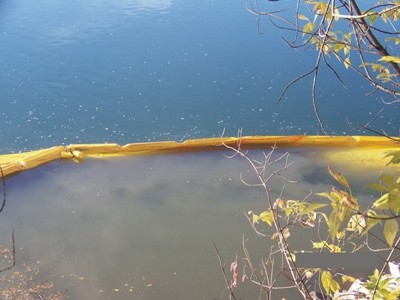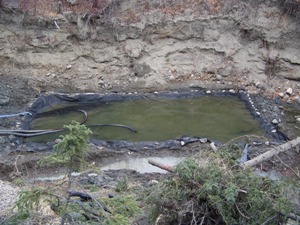Sediment Control and Traps
Erosion
and sediment control problems are often associated with
in stream work, road building, right-of-way construction
and slope failures. These problems can frequently be
prevented through planning and implementation of an
erosion and sediment control plan. A runoff, erosion
and sediment control plan includes the use of sediment
traps, in association with sediment control structures
to trap/retain suspended sediment on site or within
an enclosed in stream work area.
Sediment
traps are temporary or permanent sediment control structures
that reduce water velocity and allow soil particles
to settle. The remaining water is filtered through geotextile
or organic type structures, such as straw bales, before
entering a storm water system or natural watercourse.
Sediment traps are simple to construct and relatively
inexpensive; they can also be removed or vegetated to
anchor accumulated sediment. Monitoring and repairs
are important components of a sediment control plan.
Accumulated fill should be excavated and removed to
a stable location to increase the storage capacity.
These structures are often under estimated in their
sediment trapping capabilities; however, if designed,
constructed, and maintained correctly, they will contribute
significantly to the sediment control management of
a project.
Link to these Sediment Control Projects:
Dewatering
of Sensitive Riparian Area
(Outfall 13)
In Stream Work Using a Turbidity Curtain (Outfall 56)
Stream Bank Work Using a Turbidity Curtain (Belgravia)
Sediment
Control using Various Types of Sediment Traps (Busk Creek)
Watershed
Restoration Program using Large Sediment Traps on Slope
Failure
(Coffee Creek)
Live
Sediment Traps and Live Check Dams to Control Sediment
and Establish Vegetation (Heart Creek) |

Confinement of sediment laden water inside turbidity curtain, North Saskatchewan River, Edmonton Alberta

Sediment settling pond, Storm Water
Outfall 13 Project, Edmonton, Alberta |



